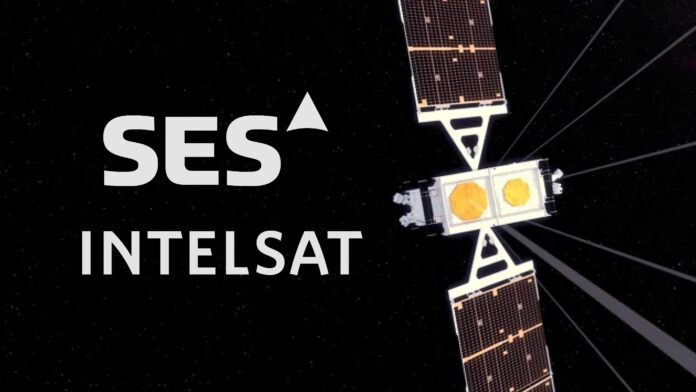Luxembourg-headquartered satellite telecoms provider SES has agreed a $3.1 billion (€2.8 billion) deal to buy US-based Intelsat. SES said the combination will create a “stronger multi-orbit operator with greater coverage, improved resiliency, expanded solutions, [and] enhanced resources”. It will provide “a compelling alternative in the new era of growth, innovation, and competition for the satellite communications industry,” it said.
The acquisition will see the two combine satellite and ground infrastructure, spectrum licences, plus investment and innovation capabilities. Between them, SES and Intelsat have 100 geostationary earth orbit (GEO) and 26 medium earth orbit (MEO) satellites, and complementary spectrum in various (C-, Ku-, Ka-, Military Ka-, X-band, and Ultra High Frequency) bands. The plan is for eight new GEO satellites and seven new MEO satellites by the end of 2026.
The strategy is to focus on “high demand and growth segments”, notably the government and mobility sectors, which would contribute about 60 percent of their joint revenue base. SES said the deal would deliver satellite connectivity for “mission-critical [government] applications… anywhere on land, at sea, or in the air”. In terms of ‘mobility’, a deal would combine Intelsat’s commercial aviation division, which serves 3,000-odd connected aircraft, and SES’s maritime business, which serves five major cruise operators.
Both firms sell managed, multi-orbit connectivity to these sectors. SES is also eyeing “fixed data and media customers”. In the first case (fixed data), it said both firms have “proven records” with telecoms providers, mobile operators, and cloud providers, and a combined business will bring “competitive offerings capable of seamless integration with cloud and 5G applications”. In the latter (media), it said a combined business units the firms’ “complementary capabilities” for pay-TV operators, free-to-air/view platforms, public and private broadcasters, and sports and events brands.
All round, SES is promising better capabilities and solutions to expand reach, add resiliency, and improve productivity. It called it an “important, transformational agreement”, which will deliver €2.4 billion of synergies (85 percent of the purchase price) at an annual rate of €370 million. Intelsat noted its own “strategic reset” over the last couple of years, to reverse a 10-year negative trend to return to growth with a “game-changing technology roadmap” and focus on focus on “productivity and execution [of]… competitive capabilities”.
SES said 70 percent of the proposed synergies will be realised within three years of the deal, which is expected to close in the second half of next year (2025), subject to regulatory clearances and filings. Most synergies will come from the combination of “selling, general, and administrative savings”, optimisation of third-party capacity costs, and streamlining satellite fleets and ground infrastructure.
The firm will issue “contingent value rights” for any sale / lease of (up to 100 MHz of) their joint C-band spectrum licences. A combined company would have a stronger financial profile compared, said SES, citing a “combined gross backlog” of €9 billion and adjusted EBITDA of €1.8 billion. It would also be in a better position, compared to either business on its own, to invest in “future network infrastructure, customer solutions, and future use-cases and business diversification opportunities with a better risk profile”.
Adel Al-Saleh, chief executive at SES, said: “In a fast-moving and competitive satellite communication industry, this transaction expands our multi-orbit space network, spectrum portfolio, ground infrastructure around the world, go-to-market capabilities, managed service solutions, and financial profile. I am excited by the opportunity to bring together our two companies and augment SES’s own knowledge base with the added experience, expertise, and customer focus of the Intelsat colleagues.”
David Wajsgras, chief executive at Intelsat, said: “The team today is providing customers with network performance at ‘five-nines’ (99.999 percent reliability) and is more dedicated than ever to customer engagement…This pivot sets the foundation for Intelsat’s next chapter. By combining… with SES, we create a more competitive, growth-oriented solutions provider in an industry going through disruptive change. The combined company will be positioned to meet customers’ needs around the world and exceed their expectations.”
The deal is to be financed with €2.4 billion in existing cash, plus new debt. It has been approved by the boards of both firms. Intelsat shareholders, with 73 percent of shares in the firm, have agreed to vote in favour of the transaction. The combined business would be headquartered in Luxembourg, with a “significant presence” in the US, mostly in the Washington DC area.

